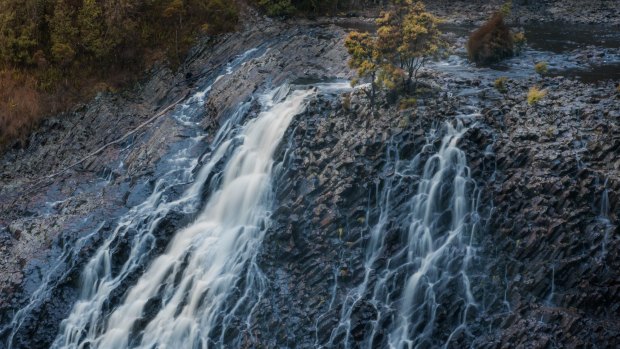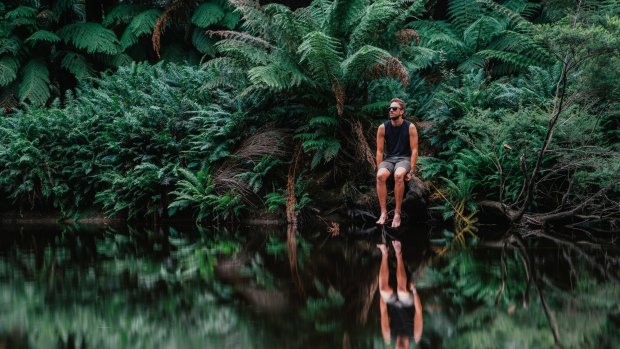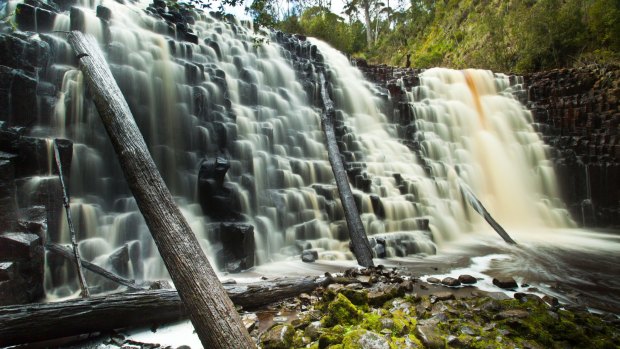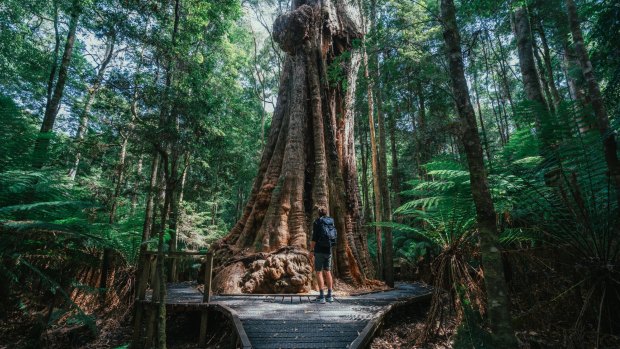This was published 4 years ago
Dip Falls and Big Tree, Dip River Forest Reserve: Tasmania's unusual hexagonal-like natural wonder

Unusual hexagonal-like natural wonder: Dip Falls.Credit: Jess Bonde
It turns out you can live in South East Tasmania for well over a decade and have little to no idea about everyday life in the island's diagonally opposite corner. Up in the North West, people snack on something called savoury toast, refer to their ute as their bus, tawdry plough rhymes with the way they pronounce laundry trough. Down one particular road is this incredible waterfall, a welcoming old family-owned apiary, a haunting tiger tale and some curious car art.
A small sign on the Bass Highway points south to Mawbanna. This is Tommeginne Country, the traditional homelands of one of the many nations of lutruwita/Tasmania – an island with a colonial history so brutal and so shameful that much has been swept under the rug of the state's collective consciousness. Mawbanna is the original name of a waterway, further east, now referred to by its English translation: Black River.
After miles of rural homesteads and cultivated paddocks I'm parking in moist bushland beside Dip River where lobster and platypus are sure to be lurking below the tannin-tinged surface. As with most Tassie rivers, the distinctive rich brown water contrasts dramatically with its green forest corridor of ferns and moss-covered tree debris. Yet no waterfall on this island ever seems to look the same.

Dip Falls is located in the Dip River Forest Reserve in Tasman's north west.Credit: Jason Charles Hill
The top of Dip Falls forms a natural infinity pool. I descend a long staircase to gaze back up at the steep field of hexagonal basalt columns. The dark rock of this 34-metre-high double-cascade feature has been eroded into thousands of individual steps. The strong winter flow hits almost every one of them before plunging into a waterhole I'd be dipping into myself if the sun was out.
Further into the reserve is a short walk to the Big Tree. Only about 13 per cent of Tasmania's old growth forest remains so it's a bittersweet embrace with this brown top stringybark towering 62 metres overhead. My hug also feels inadequate given its 16-metre-round base. I find three more gentle giants then return to the car.
There was a time when Mawbanna had a school, a regularly-used hall, a well-attended church and a place to park the firetruck. It has a history of logging operations, gold and silica mining and was a railway stop on Tasmania's Western Line, which opened in 1871.

The unique rock formations of Dip Falls. Credit: Scott Sporleder
Mawbanna is also where the last wild thylacine is reported to have been seen back in 1930. In an interview, decades later, Wilfred Batty described chasing "the tiger" around his garage and across a paddock before shooting it. In a photograph I later find online he's posed, grinning, with gun and dog and the dying thylacine macabrely propped up against a fence.
Not far from where some car bodies are perched on mid-paddock tree stumps is a place called Blue Hills Honey. Managing director and owner Nicola Charles takes my spontaneous visit in her stride and shows me around the entire site where, not unlike the hyper-productivity of bee boxes, a lot gets done in a relatively small space.
Nicola grew up in Mawbanna, travelled the world for years then came home and literally married the boy next door. Robbie Charles is from a line of beekeepers whose business officially began in 1955, making it one of the state's oldest family-owned commercial apiaries. They harvest honey, including Manuka, from some very special parts of the North West including the nearby Tarkine rainforest.

Dip River Forest Reserve is also home to the Big Tree which has a 16-metre-round base.Credit: Jason Charles Hill
To one side of their well-stocked farm shop is a projection room where they'll simulate the inner-hive experience for interested visitors. On the other side is the Colony Cafe where comfort food is created. Mark Agius makes me a hot ham and cheese toastie to dip in cool truffle hollandaise. I wash it down with ice-cold mead and a nip of whisky. When it's time to leave, Nicola slips me a bottle of Leatherwood and botanicals honey infused with Tasmanian pepperberry. Sweet.
Though before I go I just have to ask her about the cars. They're the work of Robbie's quirky-humoured nephew, she explains, and the expired vehicles are balanced on macrocarpa stumps – a tree that once lined most early residences in Mawbanna. Some people screw their noses up at the car bodies but Nicola doesn't. "They make great bee boxes."
DRIVE
Take the C225 from Bass Hwy for Blue Hills Honey and Dip Falls. A wheelchair accessible platform overlooks Dip Falls and surrounds the Big Tree. Blue Hills Honey is designed for equal access.
STAY
Ship Inn Stanley overlooks the town's port and is 30 minutes from Mawbanna. See shipinnstanley.com.au
Coastal Pods Wynyard is self-contained equal access riverside accommodation 50 minutes from Mawbanna. See coastalpods.com
Elspeth Callender stayed at Ship Inn Stanley as a guest of Tourism Tasmania, otherwise travelled at her own expense.
Sign up for the Traveller Deals newsletter
Get exclusive travel deals delivered straight to your inbox. Sign up now.